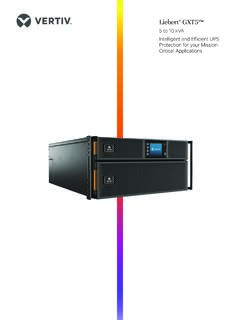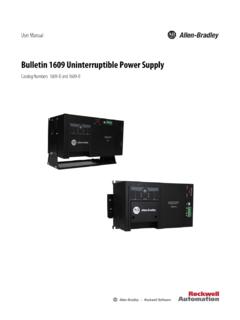Transcription of ASHRAE TC9.9 Data Center Power Equipment Thermal ...
1 1 ASHRAE Data Center Power Equipment Thermal Guidelines and Best Practices Whitepaper created by ASHRAE Technical Committee (TC) Mission Critical Facilities, Data Centers, Technology Spaces, and Electronic Equipment ASHRAE 2016 2 Data Center Power Equipment Thermal Guidelines and Best Practices Table of Contents 1. TYPICAL DATA Center Power DISTRIBUTION SYSTEM ..4 CATEGORIZING DATA Center Power Equipment BY LOCATION ..5 2. CHANGES IN DATA Center ENVIRONMENTS ..10 ASHRAE Thermal GUIDELINE CLASSES FOR IT Equipment SPACES ..10 INCREASING USE OF ECONOMIZATION IN IT Equipment SPACES.
2 12 RISING EXHAUST TEMPERATURE OF IT Equipment ..13 AIR TEMPERATURE TRENDS IN IT SUPPORT Equipment SPACES ..15 Thermal TRANSIENTS AND EXCURSIONS IN IT Equipment SPACES ..16 3. TEMPERATURE RATINGS FOR Power Equipment ..17 4. MEDIUM AND LOW VOLTAGE 5. uninterruptible Power SUPPLIES ..21 6. ELECTRICAL Power DISTRIBUTION ..30 ROOM Power DISTRIBUTION UNIT (PDU) ..30 TRANSFORMERS ..32 REMOTE Power PANEL (RPP) ..33 PANELBOARDS ..33 BUSWAYS ..34 RACK AUTOMATIC TRANSFER SWITCHES (RATS) AND RACK STATIC TRANSFER SWITCHES (RSTS) ..35 RACK Power DISTRIBUTION UNITS ..36 RECOMMENDATIONS FOR Power DISTRIBUTION Equipment .
3 42 7. HIGHER VOLTAGE DC (HVDC) Power ..44 8. ASHRAE RECOMMENDATIONS ..48 9. SUMMARY ..51 10. REFERENCES ..51 APPENDIX A 3 Acknowledgements The ASHRAE committee would like to thank the following persons for their groundbreaking work and willingness to share their subject matter knowledge in order to further the understanding of the entire data Center industry: Chuck Rabe Hewlett Packard Enterprise Darrel Gaston Hewlett Packard Enterprise Mark Lewis Hewlett Packard Enterprise David Mohr Hewlett Packard Enterprise Dave Rotheroe Hewlett Packard Enterprise Dave Kelley Emerson Network Power Eric Wilcox Emerson Network Power Kyle Wessels Emerson Network Power Jon Fitch Dell Al Dutra - Dell John W.
4 Collins Eaton Marc H. Hollingsworth Eaton Sturges Wheeler Eaton Phillip J. Fischer Eaton John Bean Schneider Electric Victor Avelar - Schneider Electric Jay Taylor Schneider Electric Marc Cram Server Technology Robert Faulkner Server Technology Joe Prisco IBM Roger Schmidt IBM William Brodsky IBM Paul Estilow DLB Associates These persons invested a significant amount of their time in conference calls, writing drafts, drawing figures, and editing and reviewing text. Thanks also to Jon Fitch (Dell) for leading the white paper team and making final edits to the paper. Special thanks to Roger Schmidt for his support on the white paper and for his leadership of the ASHRAE IT sub-committee.
5 Special thanks also to Dave Kelley (Emerson), Paul Artman (Lenovo), John Groenewold (Chase), William Brodsky (IBM), Roger Schmidt (IBM), Terry Rodgers (Primary Integration Solutions), Tom Davidson (DLB Associates), Jason Matteson (Lenovo), Joe Prisco (IBM), and Dustin Demetriou (IBM) for taking the time to do an in-depth review of the draft and for providing detailed and insightful feedback. Thanks also to Ian Bitterland, Bob Landstrom, and Harry Handlin from The Green Grid for providing helpful review comments. 4 1. Introduction Changing data Center environmental conditions are of importance to IT Equipment but also to Power Equipment , especially where the two types of Equipment share the same physical space and air stream.
6 ASHRAE s document [1], Thermal Guidelines for Data Processing Environments Fourth Edition has increased the industry s awareness of the effect increased operating temperature can have on IT Equipment . In some cases, Power Equipment can be subjected to higher temperatures than the IT Equipment . Higher temperatures can impact Equipment reliability. Exposure to warmer temperatures, coupled with the fact that usable life cycle of Power Equipment is typically longer than IT Equipment , increases the importance of this topic. This paper discusses how changes to the data Center Thermal environment may affect Power distribution Equipment .
7 This paper also provides an overview of data Center Power distribution [2] [3] and describes the typical Power Equipment used for both IT loads and non-IT loads ( lighting and cooling). Included in this list of Equipment is switchgear, uninterruptible Power supplies (UPS), static transfer switches, switchboards, transformers, Power distribution units (PDU), remote Power panels (RPP), panelboards, rack PDU, line cords, facility receptacles and IT cable trays. Note that the order in which the Power distribution Equipment is discussed is not necessarily the same order in which it would appear on an electrical diagram.
8 The paper concludes with a set of recommendations on how to improve Power Equipment Thermal compatibility and reliability. Typical Data Center Power Distribution System An electrical one-line diagram is typically used to communicate specific details of an electrical distribution design and shows the logical flow of electricity from utility mains to the IT Equipment . A block diagram, shown in Figure 1, provides a higher-level view of a data Center s electrical flow without the complexity of a one-line diagram. Figure 1 serves as a guide to show where certain types of Equipment are typically found within a data Center , both logically and physically.
9 Dashed lines are used to show in which type of space each piece of Power Equipment resides. Heavy dashed lines indicate electrical space, lines with a dash and a single dot delineate mechanical space, and the line with a dash and two dots defines the IT space. Generators, though part of the data Center Power infrastructure, are beyond the scope of this paper. In general, data Center electrical architectures start with a utility supply at medium-voltage (600 to 1000V) which feeds medium-voltage switchgear. Note: the new version of the National Electrical Code (NFPA 70 [4]), which will be released in 2017, will define medium voltage as 600 to 1000V.
10 This medium-voltage is stepped down to low-voltage (typically 480V and lower) using a transformer which then feeds low-voltage switchgear. Low-voltage switchgear generally feeds UPS units which then feed UPS output switchgear or panelboards and then feed room PDUs. Room PDUs typically provide Power to remote Power panels (RPPs) which supply branch circuits to each IT rack which then feed rack PDUs ( Power strips). Working back up the Power supply chain to the utility feed, there is a similar chain of Power distribution Equipment used for non-IT loads such as lighting and cooling Equipment .









